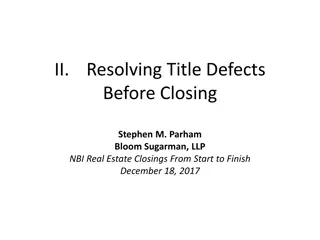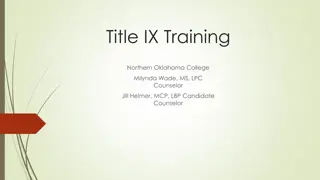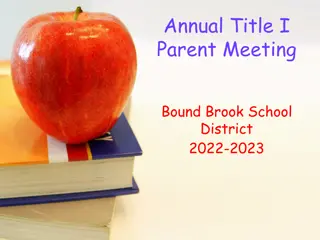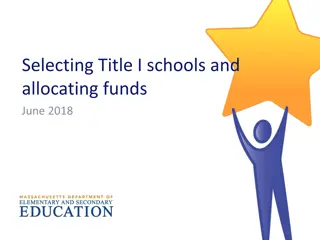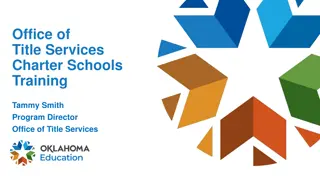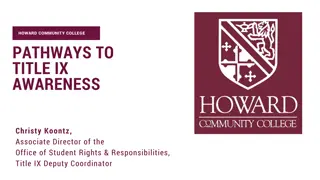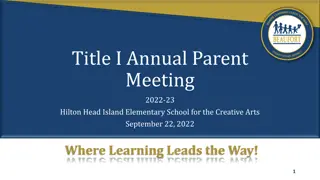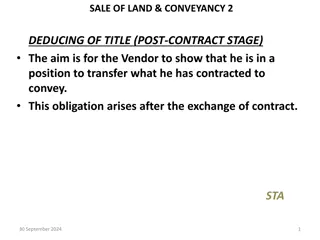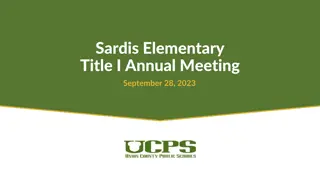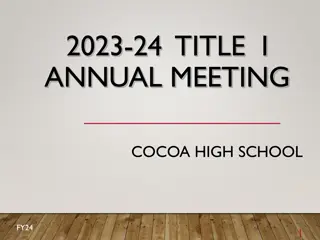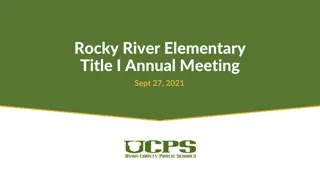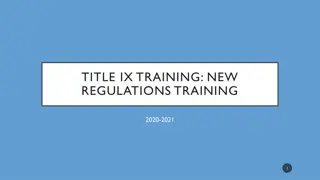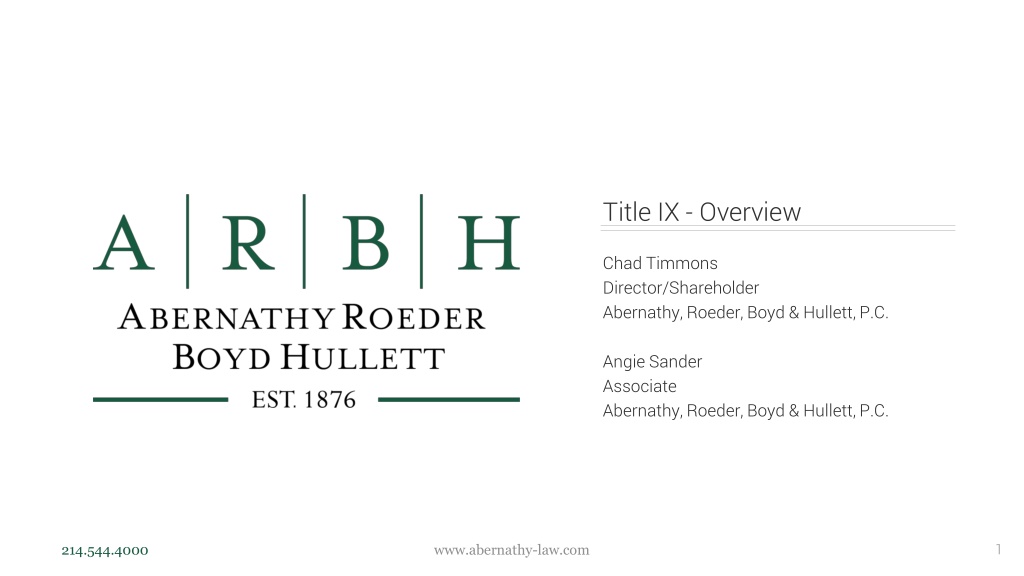
Overview of Title IX Regulations on Sexual Harassment
Learn about the Title IX regulations on sexual harassment, including new definitions, compliance dates, key terminology, and the process involved. Understand the narrower definition of sexual harassment provided in the new regulations and the types of conduct it encompasses.
Download Presentation

Please find below an Image/Link to download the presentation.
The content on the website is provided AS IS for your information and personal use only. It may not be sold, licensed, or shared on other websites without obtaining consent from the author. If you encounter any issues during the download, it is possible that the publisher has removed the file from their server.
You are allowed to download the files provided on this website for personal or commercial use, subject to the condition that they are used lawfully. All files are the property of their respective owners.
The content on the website is provided AS IS for your information and personal use only. It may not be sold, licensed, or shared on other websites without obtaining consent from the author.
E N D
Presentation Transcript
About Us Title IX - Overview Chad Timmons Director/Shareholder Abernathy, Roeder, Boyd & Hullett, P.C. Angie Sander Associate Abernathy, Roeder, Boyd & Hullett, P.C. 1 214.544.4000 www.abernathy-law.com
TITLE IX Abernathy, Roeder, Boyd & Hullett, P.C. Write it here 2 www.abernathy-law.com
Presentation Agenda Abernathy, Roeder, Boyd & Hullett, P.C. New Definitions Response Protocols Emergency Removals Investigations Procedural Requirements Dismissals Hearings Informal Removals Evidence Decisions Training Appeals Retention Scenarios 3 www.abernathy-law.com
Compliance Date Abernathy, Roeder, Boyd & Hullett, P.C. AUGUST 14, 2020 Mon Mon Tue Tue Wed Wed Thu Thu Fri Fri Sat Sat Sun Sun 01 02 03 04 05 06 07 08 09 10 11 12 13 14 15 16 17 18 19 20 21 22 23 24 25 26 27 28 29 30 31 4 www.abernathy-law.com
Who is Involved in the Process? Abernathy, Roeder, Boyd & Hullett, P.C. Informal Informal Investigator Investigator Decision Maker Decision Maker Appeals Officer Appeals Officer Title IX Coordinator Title IX Coordinator Resolution Facilitator Resolution Facilitator
New Terminology Abernathy, Roeder, Boyd & Hullett, P.C. New Terminology New Terminology Complainant: Person alleged to be the victim of sexual harassment. Respondent: Person alleged to be the perpetrator of sexual harassment. A parent may act on behalf of a minor student who is a complainant or respondent. www.abernathy-law.com
What is Sexual Harassment? Abernathy, Roeder, Boyd & Hullett, P.C. OLD DEFINITION OLD DEFINITION Previously, the regulations described sexual harassment as unwelcome unwelcome conduct conduct of of a a sexual sexual nature nature. . 7 www.abernathy-law.com
Definition Sexual Harassment Abernathy, Roeder, Boyd & Hullett, P.C. The new Title IX regulation provides for a narrower definition of sexual harassment that constitutes sex discrimination. The new definition has (3) types of sex based conduct based conduct which would constitute sexual harassment: Unwelcome conduct that is so severe, so severe, pervasive and pervasive and objectively objectively offensive offensive that it effectively denies a person equal educational access; AND (3) types of sex- - An employee conditioning the aid, benefit or service on participation of unwelcomed sexual conduct (Quid pro Quo). Sexual assault, dating violence, domestic violence, and stalking;
When is a Response Required? Abernathy, Roeder, Boyd & Hullett, P.C. The College has actual knowledge knowledge of sexual harassment; actual The alleged sexual harassment occurred within occurred within the College s the College s education program education program or activity or activity; AND Response Required The alleged sexual harassment was against a person in the United States.
When Must a College Respond? Abernathy, Roeder, Boyd & Hullett, P.C. Actual Actual knowledge knowledge notice of sexual harassment or allegations of sexual harassment to a recipient's Title IX Coordinator or any official of the recipient who has authority to institute corrective measures on behalf of the recipient, or to any employee of an elementary and secondary school.; and Any person (e.g., the alleged victim or any third party) may report to a Title IX Coordinator in person or by e-mail, phone, or mail. 10 www.abernathy-law.com
When Must a College Respond? Abernathy, Roeder, Boyd & Hullett, P.C. Education Education program over which the College exercises substantial control. Substantial control over activities includes field trips, academic conferences, or other school-sponsored travel. Substantial control also applies to College- owned buildings. program or or activity activity includes situations 11 www.abernathy-law.com
First Response Protocols Abernathy, Roeder, Boyd & Hullett, P.C. The new regulations establish a first response protocol for Title IX Coordinators. Specifically, if anyone reports sexual harassment, the Title IX Coordinator must: Promptly contact the complainant to confidentially discuss the availability of supportive supportive measures measures. Explain that supportive measures are available with or without the filing of a formal complaint. Explain to the complainant the process for filing a formal complaint. 12 www.abernathy-law.com
First Response Protocols Abernathy, Roeder, Boyd & Hullett, P.C. What are Supportive Measures? What are Supportive Measures? Individualized services to restore or preserve equal access to education, protect student and employee safety, or deter sexual harassment. Can include counseling, extensions of deadlines or other course-related adjustments, changes in work locations, leaves of absence, escort services, modifications in class or work schedules, restrictions on contact between the parties and/or increased security in certain areas of the campus. Cannot be punitive or disciplinary. Completely removing a respondent from an activity would likely be considered punitive removals. Must be provided free of charge to the complainant. except in emergency
Emergency Removals Abernathy, Roeder, Boyd & Hullett, P.C. Title IX regulations do not prohibit immediate removal of a respondent from the education program or activity on an emergency basis. This is only if the College conducts an individualized safety and risk analysis and determines emergency removal is necessary in order to protect a student or other individual from an immediate threat to physical health or safety. The College must provide the respondent with notice and an opportunity to challenge the decision immediately after the removal. 14 www.abernathy-law.com
Formal Complaint Abernathy, Roeder, Boyd & Hullett, P.C. What is a formal complaint? What is a formal complaint? A formal complaint is a document filed by the complainant or signed Coordinator alleging against a respondent and requesting an investigation into the allegations. by the Title IX sexual harassment www.abernathy-law.com
Title IX Coordinator Abernathy, Roeder, Boyd & Hullett, P.C. An administrator designated as the Title IX Coordinator to coordinate efforts to comply with Title IX responsibilities. The Title IX Coordinator s information including title, address, email and phone number must be given to: Parents and Legal Guardians of elementary and secondary school students; Students; Employees; Applicants for admission; and Applicants for employment www.abernathy-law.com
Investigations Abernathy, Roeder, Boyd & Hullett, P.C. Colleges must investigate allegations in any formal complaint and send send complainant, respondent and their parents of the allegations upon receipt of a formal complaint. written written notice notice to the 17 www.abernathy-law.com
Written Notice Abernathy, Roeder, Boyd & Hullett, P.C. Include presumption of innocence at the onset of the grievance process; Inform both parties of the College s grievance process; Include if there is an opportunity for an informal resolution process; Include key details of the allegations of sexual harassment including parties involved, date and location of the alleged incident (if known), and the alleged conduct that constitutes sexual harassment; Include a statement that the parties are entitled to an advisor of their choice; Notice that the parties can inspect and review certain evidence; Include information regarding any provisions from the Code of Conduct (if one exists) regarding making false statements during the grievance process; and If in the course of an investigation, the College decides to investigate allegations about the respondent or complainant that were not included in the original notice, notice of the additional allegations must be provided in writing to the parties.
Investigations Abernathy, Roeder, Boyd & Hullett, P.C. The burden of gathering evidence during the investigation remains on the Colleges. Colleges must provide equal opportunity for the parties to present facts, witnesses, and any other evidence. Colleges cannot restrict the ability of the parties to discuss the allegations or gather evidence. Both parties must be allowed an opportunity to select an advisor who may be, but does not need to be, an attorney. Colleges must send written notices of any investigative interviews, meetings, or hearings. 19 www.abernathy-law.com
Investigations Abernathy, Roeder, Boyd & Hullett, P.C. Colleges are required to disclose to the parties and their advisors any evidence directly related to the allegations and an investigative report that summarizes relevant evidence with at least ten days for the parties to inspect, review, and respond. Colleges cannot access any medical, psychological, or similar treatment records without written consent. The investigator cannot be the Title IX coordinator and cannot be the decision-maker. 20 www.abernathy-law.com
Procedural Requirements Abernathy, Roeder, Boyd & Hullett, P.C. A presumption of innocence is required throughout the process. The respondent is not responsible for the alleged conduct until a determination is made at the conclusion of the grievance process. Written notice of allegations and an equal opportunity for the parties and their advisors to review the evidence is required. Protect any individual, including complainants, respondents, and witnesses, from retaliation for reporting sexual harassment or participating (or refusing to participate) in any Title IX grievance process. Provide remedies when a respondent is found responsible. The remedies must be designed to maintain the complainant s equal access to education. An equal opportunity must be available for parties to appeal on specified grounds. 21 www.abernathy-law.com
Mandatory Dismissals Abernathy, Roeder, Boyd & Hullett, P.C. The alleged sexual harassment did not occur in the College s education program or activity. The claim does not meet the definition of sexual harassment. The alleged sexual harassment did not occur in the United States of America. Mandatory Dismissal* *Colleges can still investigate these claims under their Code of Conduct.
Discretionary Dismissals Abernathy, Roeder, Boyd & Hullett, P.C. If the respondent is no longer employed by or enrolled in the College. If there is a specific circumstance which prevents the College from gathering sufficient information in order to make a decision about the allegations. If the complainant notifies the Title IX coordinator in writing that the complainant wishes to withdraw the formal compliant or some of its allegations. Discretionary Dismissal
Hearings Abernathy, Roeder, Boyd & Hullett, P.C. Postsecondary institutions are required to hold hearings before a determination is reached. The College must send the finalized version of the investigative report to the parties so they can submit a written responses. Each party must must be be allowed allowed to submit written questions for witnesses and must be provided with the answers. The parties should be given additional time for limited follow-up questions. The investigative report must be sent at least 10 days before a hearing. 24 www.abernathy-law.com
Informal Resolutions Abernathy, Roeder, Boyd & Hullett, P.C. Colleges are not required to but are able to facilitate a resolution through an informal process. With the exception of one type of claim, Colleges can provide parties with written notice of the allegations, the requirements of the informal resolution process, and any consequences from participating (i.e. records that will be maintained and could be shared), and obtain voluntary written consent to use the informal resolution process. Informal resolutions must be before a neutral third party who is trained. 25 www.abernathy-law.com
No Informal Resolutions Abernathy, Roeder, Boyd & Hullett, P.C. Colleges cannot resolution process to resolve allegations that an employee sexually harassed a student. This is because of the power differentials inherent in such circumstances. cannot offer or facilitate an informal 26 www.abernathy-law.com
Rape Shield Abernathy, Roeder, Boyd & Hullett, P.C. The new Title IX legislation provides rape shield protections to complainants. All questions and evidence about a complainant s prior sexual behavior will be deemed irrelevant. It will only be allowed to prove that someone other than the respondent committed the alleged misconduct, or it can be offered to prove consent. 27 www.abernathy-law.com
Standard of Evidence Abernathy, Roeder, Boyd & Hullett, P.C. Colleges can choose which standard of evidence they want to use but must use the same standard for all proceedings with students and employees. Preponderance of Evidence Preponderance of Evidence Clear and Convincing Evidence Clear and Convincing Evidence 28 www.abernathy-law.com
Standard of Evidence Abernathy, Roeder, Boyd & Hullett, P.C. Clear and Convincing Evidence being presented must be highly and substantially more probable to be true rather than untrue. Higher standard of proof.
Standard of Evidence Abernathy, Roeder, Boyd & Hullett, P.C. Preponderance of Evidence More likely than not, or anything above a fifty- fifty likelihood of guilt. Standard under the old rule.
Decision Makers Abernathy, Roeder, Boyd & Hullett, P.C. The decision-maker needs to objectively evaluate the evidence and reach a conclusion regarding the sexual harassment claims. The decision maker cannot cannot be the same person who conducted the investigation and cannot be the same as the Title IX Coordinator. Decision makers must be free from conflicts of interests or bias for or against either party. Decision makers must receive special training on how to be impartial and how to determine what evidence is relevant. The decision maker must issue a written decision (even if there is no hearing). 31 www.abernathy-law.com
Written Decisions Abernathy, Roeder, Boyd & Hullett, P.C. The written decision must include the following: The portion of the College s policy that was violated. A description of all the procedural steps that were taken by the College. This includes all the interviews that were conducted. A findings of facts section. A section that draws a conclusion after the finding of facts. A statement or rationale for the ultimate determination. 32 www.abernathy-law.com
Written Decisions Abernathy, Roeder, Boyd & Hullett, P.C. Any disciplinary actions the College will impose on the respondent and state if any remedies are provided to the complainant. A statement and rationale for any remedies provided to the complainant, and explain how that remedy will restore or preserve equal access to education. A statement of the procedures, the right to appeal, and permissible basis for appeal. 33 www.abernathy-law.com
Training Abernathy, Roeder, Boyd & Hullett, P.C. The new regulations place a heavy emphasis on training. Colleges must ensure Title Title IX IX Coordinators, Coordinators, investigators, and and any any person person who who facilitates facilitates an receive training on the following: The definitions of prohibited conduct, including harassment; How both the informal and formal processes work; How to serve impartially, including by avoiding prejudgment of the facts at issue, conflicts of interest and bias; and How to apply the rape shield protections provided for complainants. investigators, decision an informal informal resolution decision- -makers, resolution process makers, process, 34 www.abernathy-law.com
Training Abernathy, Roeder, Boyd & Hullett, P.C. Colleges materials used to train Title IX personnel publicly available on the College s website or, if the College does not maintain a website, make these materials available upon inspection by members of the public. must make all request for 35 www.abernathy-law.com
Appeals Abernathy, Roeder, Boyd & Hullett, P.C. Colleges must offer both parties an appeal from a determination regarding: Responsibility; and From a College s dismissal of a formal complaint. Both parties can appeal for the following reasons: Procedural irregularity that affected the outcome of the matter; Newly discovered evidence that could affect the outcome of the matter; and/or Conflict of interest or bias by Title IX personnel that affected the outcome of the matter. 36 www.abernathy-law.com
Retention Abernathy, Roeder, Boyd & Hullett, P.C. Colleges must keep the following records for a minimum of seven (7) years: Records of a College s investigation; Records of any appeals and materials from the appeal; Records of any informal resolution process; Title IX training materials; and 1. Title IX coordinators, investigators, decision makers, and any employee designated to facilitate an informal process. 2. Colleges must also post the training material on their websites, or, if a College does not maintain a website, otherwise make the materials available to the public. Records of any supportive measures taken. 1. If no supportive measures were taken, the Colleges should document why supportive measures were not needed. 37 www.abernathy-law.com
Title IX Flow Chart Abernathy, Roeder, Boyd & Hullett, P.C. Determine if supportive measures are needed and/or emergency removal is required. Knowledge of inappropriate conduct that is sexual in nature. Title IX Coordinator communicates with alleged victim. Formal Complaint is filed. Does the allegation meet the new sexual harassment definition? Notice of Formal Complaint. Investigation. Written Report. Questions submitted by either or both parties. Decision. Appeal. www.abernathy-law.com
Scenario Abernathy, Roeder, Boyd & Hullett, P.C. A college has a designated Title IX officer. This person s contact information is published on the school s website, handbooks and posters. A student reports a sexual assault by another student to the librarian. The alleged incident occurred after school hours in a classroom. What are the next steps? Is the librarian responsible for taking any steps? www.abernathy-law.com
Scenario Abernathy, Roeder, Boyd & Hullett, P.C. The student reporting the alleged incident to the librarian may actual actual knowledge, knowledge, if librarian has authority to institute corrective measures on behalf of the recipient. . If librarian has authority, then there is a duty to provide supportive measures. www.abernathy-law.com
Scenario Abernathy, Roeder, Boyd & Hullett, P.C. The Title IX Coordinator has reached out to the alleged victim and offered supportive measures. Which one of the following is not not an appropriate supportive measure? A. Counseling. B. Schedule Change. C. Expelling the alleged perpetrator. D. Allowing the alleged victim to have additional time to finish a project. www.abernathy-law.com
Scenario Abernathy, Roeder, Boyd & Hullett, P.C. A. Counseling. B. Schedule Change. C. C.Expelling Expelling the D. Allowing the alleged victim to have additional time to finish a project. the alleged alleged perpetrator perpetrator. . www.abernathy-law.com
Scenario Abernathy, Roeder, Boyd & Hullett, P.C. The alleged victim wishes to file a formal complaint. What is needed for a formal complaint? www.abernathy-law.com
Scenario Abernathy, Roeder, Boyd & Hullett, P.C. Document filed by a complainant or signed by the Title IX Coordinator; Allegation of sexual respondent; and Request that the school allegations of sexual harassment. harassment against a investigate the www.abernathy-law.com
Scenario Abernathy, Roeder, Boyd & Hullett, P.C. Now that you have a formal complaint, how many employees required for this process from start to finish (filing of the complaint to appeal)? are potentially www.abernathy-law.com
Scenario Abernathy, Roeder, Boyd & Hullett, P.C. Informal Informal Investigator Investigator Decision Maker Decision Maker Appeals Officer Appeals Officer Title IX Coordinator Title IX Coordinator Resolution Facilitator Resolution Facilitator
Scenario Abernathy, Roeder, Boyd & Hullett, P.C. The allegations state the incident occurred after school hours in the classroom. Is the College required to dismiss the complaint because it was after hours? www.abernathy-law.com
Scenario Abernathy, Roeder, Boyd & Hullett, P.C. NO! Education program or activity includes situations over which the College exercised substantial control. The classroom is in a building owned by the College. The College is considered to have have substantial control over any building it owns. www.abernathy-law.com
Scenario Abernathy, Roeder, Boyd & Hullett, P.C. During complainant files a second formal complaint against the same respondent alleging an incident of sexual harassment that students were on a group trip to Europe. What should the College do? the course of the investigation, the occurred while the www.abernathy-law.com
Scenario Abernathy, Roeder, Boyd & Hullett, P.C. The College should dismiss the claim because the incident did not occur in the United States. This would be a mandatory dismissal. This does not preclude the College from investigating the allegations under the College s code of conduct. www.abernathy-law.com



